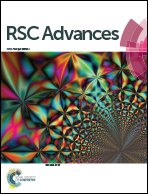Synthesis and properties of a nano-silica modified environmentally friendly polyurethane adhesive
Abstract
In this study, a nano-SiO2 modified waterborne polyurethane (WPU) adhesive with remarkably low VOC content and high adhesion performance was successfully synthesized via in situ polymerization. The influence of nano-silica concentration on different properties of the aqueous-based adhesive and the casted films was carefully investigated. When the concentration of nano-SiO2 was in the range of 2.0–2.5%, the performance of the adhesive reached the optimum. When the nano-silica content is about 2.0 wt%, the appearance of the emulsion was milky white with a blue light. The T-peel and shear strength of the nano-modified adhesive showed essential improvement compared with pure-WPU adhesive. The results of shear adhesion failure temperature tests showed that the thermo-tolerance temperature of the adhesive was higher than 175 °C. The tensile strength, elongation at break and water swelling of the casted films were about 21.3 MPa, 890% and 2.7%, respectively. Finally, other properties of the water-based adhesive were investigated using FTIR, SEM, molecular weight, pH, mean particle size and solid content measurements.


 Please wait while we load your content...
Please wait while we load your content...